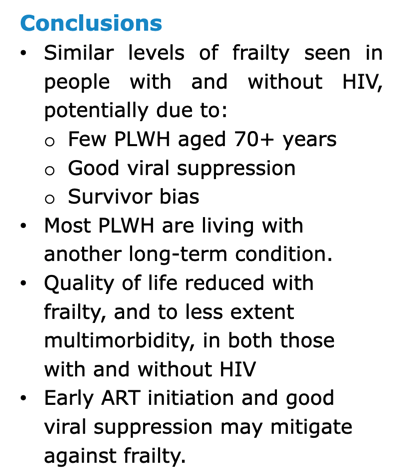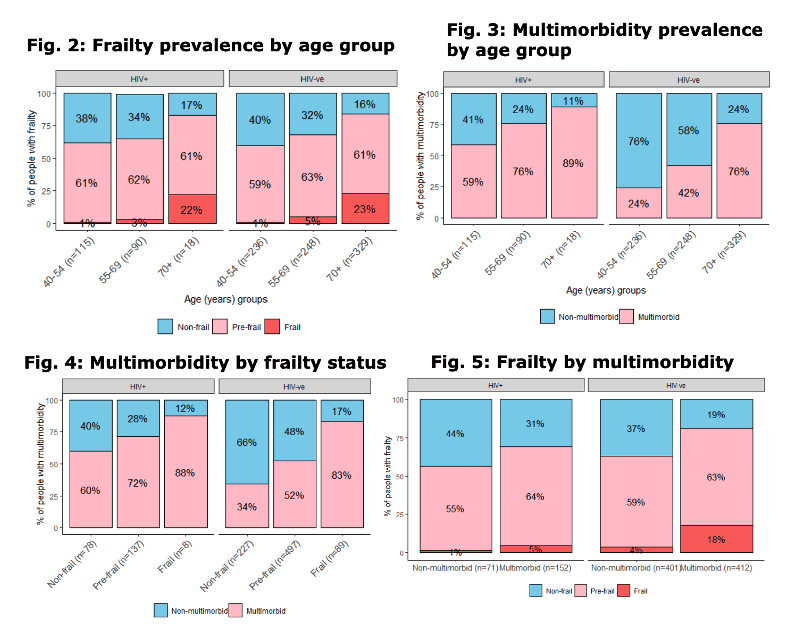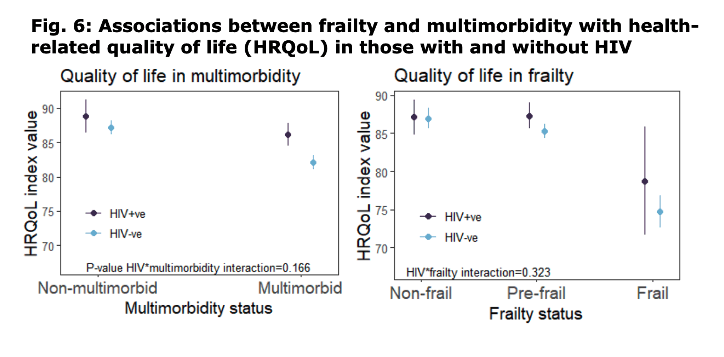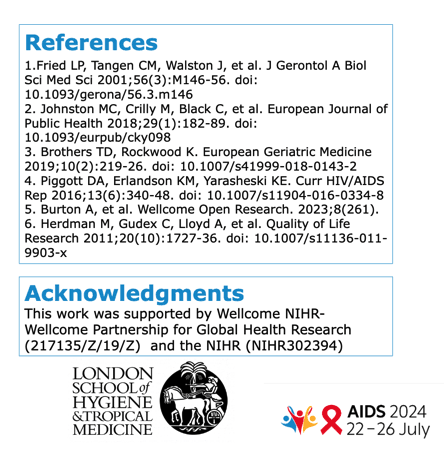 |
 |
 |
| |
Frailty and multimorbidity in mid-aged and older
adults living with HIV: a cross-sectional study in Zimbabwe
|
| |
| |
A.M. Manyara1, T. Manyanga2, A. Burton1, H. Wilson1, J. Chipanga2, T. Bandason2, R.A. Ferrand2,3, C.L. Gregson4,2
Institutions
1Univerisity of Bristol, Global Health and Ageing Research Unit, Bristol, United Kingdom, 2Biomedical Research and Training Institute, The Health Research Unit Zimbabwe, Harare, Zimbabwe, 3London School of Hygiene and Tropical Medicine, Clinical Research Department, London, United Kingdom, 4University of Bristol, Global Health and Ageing Research Unit, Bristol, United Kingdom

BACKGROUND: We aimed to determine the prevalence and factors associated with frailty and multimorbidity in people living with HIV (PLWH).
METHODS: This population-based cross-sectional study recruited, by GIS-mapped household sampling, men and women aged =40 years in Harare, Zimbabwe. Data were collected using researcher-administered questionnaires, physical assessments (e.g., handgrip strength) and blood tests (including HIV status, if consenting). Frailty was defined using the five Fried criteria: unintentional weight loss, exhaustion, low physical activity, low gait speed, low handgrip strength. Presence of =3 criteria defined frailty, 1-2 pre-frailty, and absence (0) robust. Long-term conditions defining multimorbidity were based on self-reported diagnosis or diagnosis based on measurements (e.g., blood pressure/glucose). Adjusted regression models were used to analyse data.
RESULTS: The 1109 participants had mean(SD) age of 62.5(14.1) years, 51.6% female. Of 1034(93.2%) with HIV status data, 21.6% (n=223) were living with HIV: 6.4% were newly diagnosed; 96.2% of those who knew their status were on antiretroviral treatment (ART), whilst 89.7% of those on ART had a viral load <50 copies/mL. The prevalence of frailty, prefrailty and robust in PLWH was 3.6%, 61.4%, and 35% respectively. In addition to HIV, 32.7% were living with =2 conditions, 36.3% with one condition and 30.9% with only HIV. Time since HIV diagnosis and treatment duration were both independently associated with frailty, but not multimorbidity: independent of age and ART duration, living with HIV was associated with pre-frailty or frailty (adjusted odds ratio [aOR]=2.03 (95%CI 1.03-4.13), for each 5-years lived with HIV) while, independent of age and years lived with HIV, ART duration was protective, 0.39 (0.19-0.78) for each 5-years on ART. PLWH had higher odds of prior tuberculosis (7.92 (4.32-15.05)) and comorbid cancer (2.74 (0.77-9.08)), albeit marginally, compared with people without HIV. Frailty and multimorbidity were associated with a lower health-related quality of life in PLWH, although the associations were similar in people without HIV.
CONCLUSIONS: Sixty-five percent of PLWH aged 40-83 years were frail or pre-frail, while 33% were living with 2 or more long-term conditions necessitating interventions to prevent or manage frailty and multimorbidity. Early ART initiation and good viral suppression are interventions that could protect against frailty.



|
| |
|
 |
 |
|
|